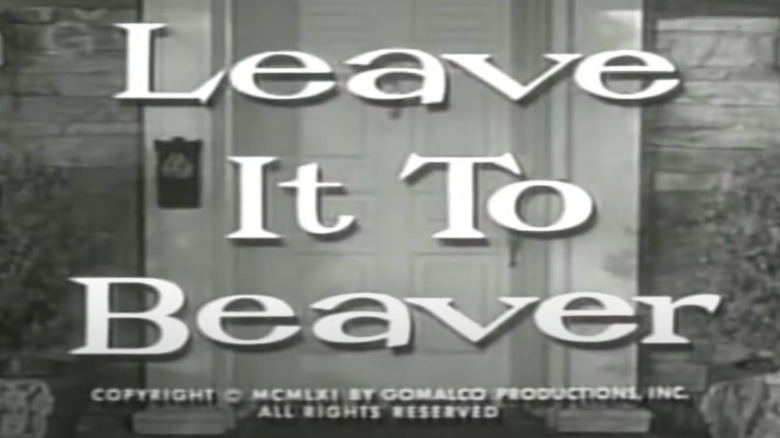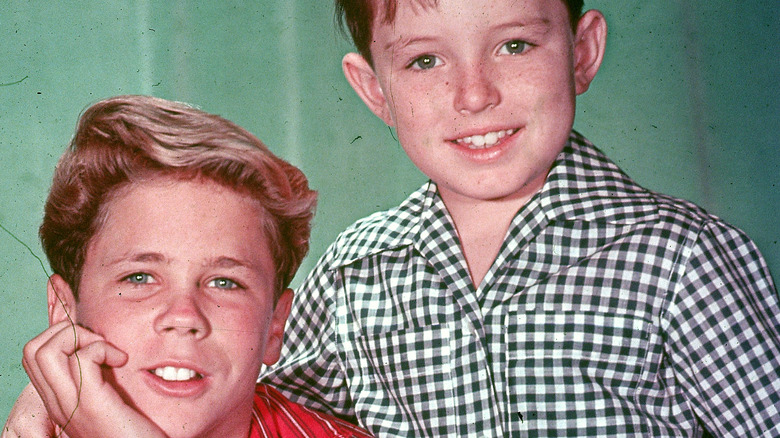The Real Reason Leave It To Beaver Was Cancelled
"Leave It To Beaver," the beloved sitcom that ran for six seasons between 1957-1963, occupies a weird place in American pop-culture history. On the one hand, the show won accolades both while it was on (including two Emmy nominations) and after it had been off the air for decades (including The Beaver making Bravo's list of the top 100 TV characters). On the other hand, today the show is Exhibit A when discussing the comically-quaint wholesomeness of TV in those days; like other shows, it steadfastly went out of its way to acknowledge mundane realities of everyday life, such as people using the bathroom.
Nowadays, a network family sitcom, such as Modern Family or The Goldbergs, can run for a decade or more. But, in the early days of broadcast TV, writers weren't as skilled at creatively writing storylines for when the children in the show become adults. However, when the two main actors in "Leave It To Beaver" reached places in their lives when they wanted to do things that other people their age do, instead of acting, the network simply pulled the plug on the hugely popular show and, in a first, produced a series finale rather than just another episode.
Jerry Mathers Wanted To Go To High School
Before getting into why "Leave It To Beaver" was canceled — for good — it bears noting that the show was actually canceled twice. As Showbiz Cheat Sheet reports, its ratings for Season 1 were middling at best, and CBS didn't renew it. However, in a reality that still happens to this day in network TV, another network, ABC, saw hope in the show and picked it up. It was, of course, the right decision, as the show would go on to air for five more seasons and become a cultural juggernaut in the process.
The two key characters in the show were the younger, precocious Theodore "Beaver" Cleaver, and his older brother, Wally, portrayed by Jerry Mathers and Tony Dow, respectively. And, although Beaver and Wally were broadcast into Americans' homes on a weekly basis for six years, Mathers and Dow were real young men who, like all real young men, grow up and live through life experiences. Mathers, in particular, couldn't stay young and precocious forever, and though he spent the better part of his early years in front of the TV cameras, as he entered his teens he found himself wanting to do things that other teens do. Specifically, according to Showbiz Cheat Sheet, he wanted to attend high school. The show's title character leaving would pretty much doom the show, or at the very least, make it extremely weird, so the producers made the decision to bring it to a satisfying conclusion.
Leave It To Beaver Sets A Precedent
These days, when a show is canceled (and when the show's writers and producers are given enough warning), it's pretty much standard practice that the show will be given a sendoff — a final episode that ties up any loose ends, wraps up the characters' story arcs, and perhaps sets them up for new adventures in new contexts. However, in the "Leave It To Beaver" days, shows just ... ended, without any sort of denouement. For example, the final episode of "I Love Lucy" was just another episode; in keeping with the show's formula, Lucy got in over her head and comical hijinks ensued. That was it.
However, the "Leave It To Beaver" writers changed things up, in the process setting up a formula that would inform TV writers for the next several decades. Specifically, according to Showbiz Cheat Sheet, the writers sent Wally off to college. That may seem mundane, but in fact, the entire premise of the show's comedy and warmth stemmed from the relationship between the two lads. In sending Wally off to college, they addressed a reality that was (and is) true for American men his age, as well as providing a wrap-up that let the audience know the show was over. These days, rare is the network TV show that doesn't end with some kind of tieing up of loose ends — at least, when the writers have been given enough warning to be able to write one.


